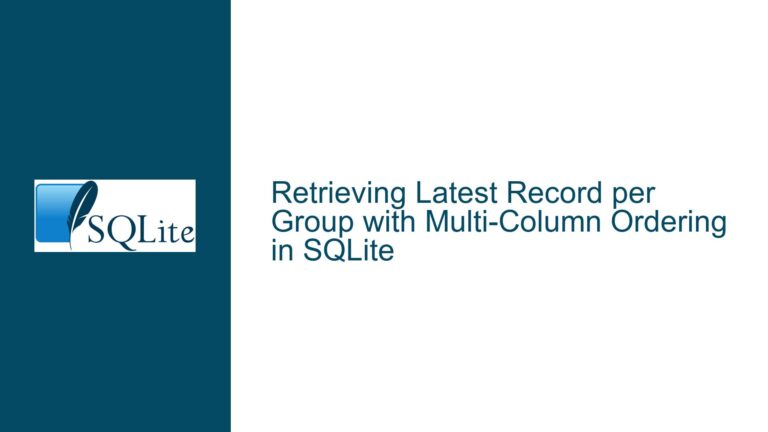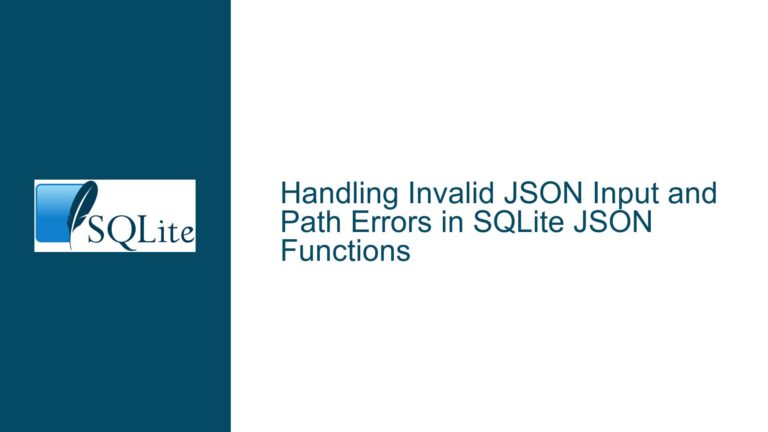SQLite RETURNING Clause Metadata Issue: Causes and Workarounds
Understanding the RETURNING Clause Metadata Limitation in SQLite
The RETURNING clause in SQLite is a powerful feature that allows users to retrieve the values of rows that are affected by INSERT, UPDATE, or DELETE operations. This feature is particularly useful in scenarios where you need to confirm the changes made to the database or use the returned data for further processing. However, a significant limitation arises when attempting to access metadata for columns returned by the RETURNING clause. Specifically, functions like sqlite3_column_origin_name() and sqlite3_column_decltype() do not work as expected with the RETURNING clause. This limitation can be problematic for applications that rely on column metadata for dynamic data handling or type validation.
The issue stems from the way SQLite internally handles the RETURNING clause. When SQLite generates bytecode for the RETURNING clause, it does not retain the metadata information about the returned columns. This means that while you can retrieve the column names, other metadata such as the origin table name or declared data type is not available. This limitation is not a bug but rather a design choice influenced by the trade-offs between implementation complexity, performance, and the utility of the metadata.
Why Metadata for RETURNING Columns is Unavailable
The unavailability of metadata for RETURNING columns is rooted in SQLite’s internal architecture and the trade-offs made during the implementation of the RETURNING clause. When SQLite prepares a statement with a RETURNING clause, it generates bytecode that executes the query and returns the specified columns. However, the metadata about these columns, such as their origin table or declared type, is not preserved during this process. This is because the RETURNING clause is designed to be lightweight and efficient, focusing on returning the data rather than the metadata.
One of the primary reasons for this design choice is performance. Metadata retrieval requires additional CPU cycles and memory, even if the metadata is never accessed. For most applications, the metadata is not essential, and the overhead of computing and storing it would be unnecessary. Moreover, implementing metadata support for RETURNING columns would require a significant refactoring of SQLite’s internal codebase. This refactoring would not only be time-consuming but also introduce the risk of new bugs, which could affect the stability and reliability of SQLite.
Another factor is the limited utility of metadata in the context of the RETURNING clause. In most cases, the data returned by the RETURNING clause is used directly without requiring additional metadata. For example, if you insert a row into a table and use the RETURNING clause to retrieve the inserted values, you typically know the structure of the returned data and do not need metadata to interpret it. Therefore, the benefits of adding metadata support for RETURNING columns are outweighed by the costs in terms of development effort, performance overhead, and potential risks.
Addressing the RETURNING Clause Metadata Limitation: Workarounds and Best Practices
Given the unavailability of metadata for RETURNING columns, it is essential to adopt alternative approaches to achieve the desired functionality. Here are some strategies and best practices to work around this limitation:
Avoid Reliance on Metadata for RETURNING Columns: If your application relies on metadata for RETURNING columns, consider redesigning your approach to minimize or eliminate this dependency. In most cases, the data returned by the RETURNING clause can be used directly without requiring additional metadata. For example, if you know the structure of the returned data, you can hardcode the expected column types and names in your application logic.
Use Explicit Column Aliases: When using the RETURNING clause, you can explicitly specify column aliases to provide meaningful names for the returned columns. This approach can help you avoid the need for metadata by ensuring that the returned columns have predictable names. For example, instead of relying on
sqlite3_column_origin_name(), you can use aliases likeRETURNING column_name AS alias_name.Leverage Application-Level Type Handling: If your application requires type information for the returned columns, consider handling this at the application level rather than relying on SQLite’s metadata. For example, you can define the expected types for the returned columns in your application code and use this information to validate or process the data. This approach shifts the responsibility of type handling from the database to the application, reducing the need for metadata.
Use Separate Queries for Metadata: If metadata is essential for your application, consider using separate queries to retrieve the necessary information. For example, after executing a query with a RETURNING clause, you can execute a second query to retrieve the metadata for the affected columns. This approach allows you to access the metadata without modifying the RETURNING clause, although it may introduce additional overhead.
Consider Alternative Databases: If metadata support for RETURNING columns is critical for your application, you may want to evaluate alternative databases that provide this functionality. While SQLite is a lightweight and efficient database, other databases may offer more comprehensive metadata support. However, this approach should be considered carefully, as switching databases can introduce significant complexity and compatibility issues.
Contribute to SQLite Development: If metadata support for RETURNING columns is essential for your use case and you have the resources, consider contributing to SQLite’s development. SQLite is an open-source project, and contributions from the community are welcome. By implementing the necessary changes and submitting a patch, you can help address this limitation and improve SQLite for all users. However, this approach requires a deep understanding of SQLite’s internal architecture and a significant time investment.
In conclusion, while the unavailability of metadata for RETURNING columns in SQLite can be a limitation, there are several strategies to work around this issue. By understanding the underlying causes and adopting best practices, you can effectively manage this limitation and continue to leverage the power of the RETURNING clause in your applications. Whether you choose to avoid reliance on metadata, use explicit column aliases, or handle type information at the application level, these approaches can help you achieve your goals without compromising performance or stability.






